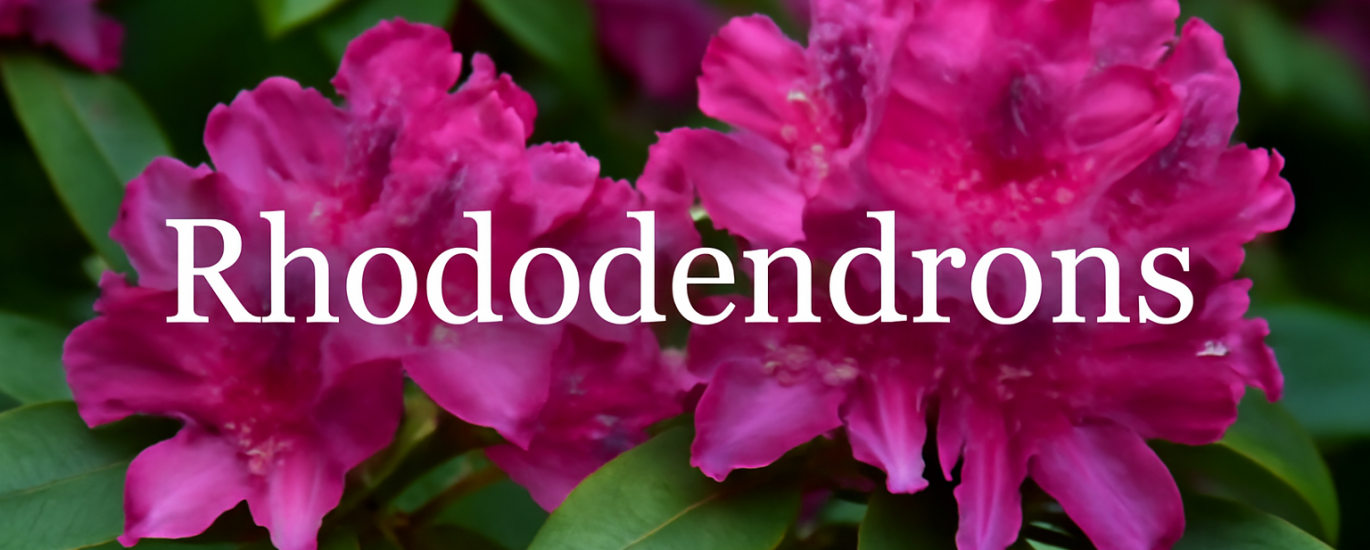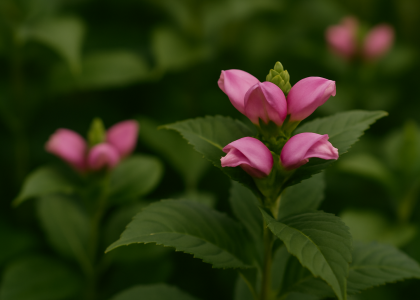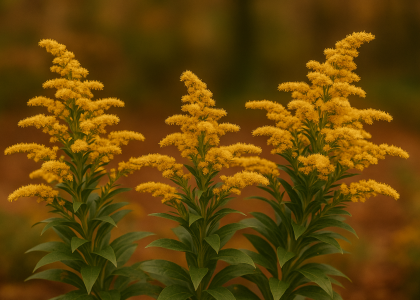Rhododendrons (Rhododendron spp.) are a beloved group of flowering shrubs and small trees known for their vibrant, showy blooms and glossy evergreen leaves. With a vast range of colors, sizes, and growth habits, Rhododendrons make an excellent choice for adding color, texture, and year-round interest to your garden. These stunning plants are perfect for woodland gardens, mixed borders, or as specimen plants. While they require specific care and growing conditions, with the right environment, Rhododendrons will thrive and reward you with beautiful flowers every spring. In this guide, we will provide you with all the essential information on planting, caring for, and propagating Rhododendrons, along with expert tips to help them flourish in your garden.
What are Rhododendrons?
Rhododendrons are large shrubs or small trees belonging to the Ericaceae family. They are known for their large, colorful flowers that bloom in spring, often in shades of pink, red, white, purple, or yellow. In addition to their flowers, Rhododendrons have glossy, dark green leaves that provide structure and beauty to the garden year-round. Rhododendrons are widely planted in woodland gardens, foundation plantings, and mixed borders. There are many different species and cultivars of Rhododendrons, including both evergreen and deciduous varieties, making them suitable for various climates and garden styles.
Key Features of Rhododendrons:
- Flower Color: Pink, Red, White, Purple, Yellow
- Foliage Color: Evergreen (glossy green) or Deciduous (green to red in fall)
- Height: 3 to 20 feet (depending on species and cultivar)
- Width: 4 to 15 feet
- Blooming Season: Spring (usually April to May)
- Hardiness Zones: 4-9 (depending on variety)
- Special Features: Fragrant flowers, evergreen foliage (in many varieties), attracts pollinators
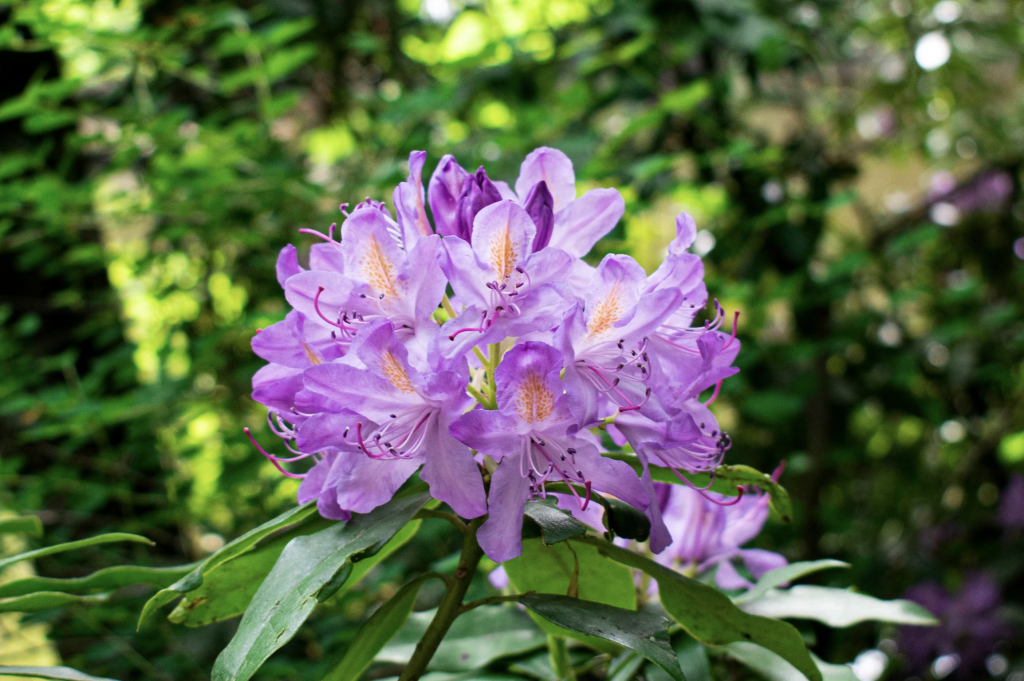
Where to Plant Rhododendrons
Rhododendrons prefer cool, shaded environments, although they can tolerate some sun, especially in cooler climates. These plants are ideal for woodland gardens, shaded borders, or locations with protection from the hot afternoon sun. Rhododendrons need well-drained, acidic soil with a pH between 4.5 and 6.0. Their roots are shallow and sensitive to poor drainage, so planting in the right location is crucial for their success.
Ideal Planting Locations:
- Woodland Gardens: Rhododendrons thrive in areas with filtered sunlight, making them perfect for shaded woodland gardens.
- Shaded Borders: Plant Rhododendrons in the partial shade of trees or along the edges of shaded borders for a burst of color in the spring.
- Containers: Smaller varieties of Rhododendrons can also be grown in containers, making them an excellent choice for patios, decks, or balconies.
- Foundation Plantings: Use Rhododendrons near the foundation of your house for added beauty and year-round structure.
Expert Tip: In regions with hot summers, plant Rhododendrons in a spot with afternoon shade to protect them from leaf scorch.
How to Plant Rhododendrons
Planting Rhododendrons correctly will ensure they establish strong roots and bloom beautifully year after year. Here’s how to plant them:
- Best Time to Plant: The best time to plant Rhododendrons is in early spring or fall, allowing the plant to establish roots before the heat of summer or the cold of winter.
- Planting Hole: Dig a hole that is two to three times the width of the root ball and about the same depth. Ensure the top of the root ball is level with the surrounding soil to avoid burying the crown.
- Soil: Rhododendrons prefer acidic, well-draining soil. If your soil is alkaline, amend it with peat moss or organic matter to lower the pH and improve drainage.
- Mulching: Apply a 2-3 inch layer of mulch around the base of the plant to retain moisture, suppress weeds, and keep the soil temperature consistent.
Expert Tip: Water the plant deeply after planting, but avoid overwatering. Rhododendrons prefer moist but not waterlogged soil.
Rhododendron Care: Keeping Your Plant Thriving
Rhododendrons are relatively low-maintenance once established, but they do require some care to ensure they grow strong and bloom beautifully.
Light Requirements:
Rhododendrons grow best in partial shade to full shade, especially in warmer climates. Too much direct sunlight, especially during the afternoon, can cause the leaves to scorch, leading to poor growth and fewer flowers. In cooler climates, Rhododendrons can tolerate full sun, but they may need some protection from harsh summer heat.
Watering:
Rhododendrons prefer moist, well-drained soil. They do not tolerate dry soil or poor drainage. Water regularly, especially during dry periods, but make sure the soil doesn’t become soggy. Rhododendrons have shallow roots, so it’s important to keep the root zone consistently moist.
Expert Tip: Water deeply to encourage deep root growth, but avoid watering overhead, as wet foliage can encourage fungal diseases.
Soil and Fertilizing:
Rhododendrons need acidic soil (pH 4.5 to 6.0) to thrive. They prefer well-draining, organic-rich soil. Fertilize Rhododendrons in early spring with a specialized fertilizer for acid-loving plants. Avoid fertilizing in late fall, as this can encourage tender growth that may be damaged by winter frost.
Expert Tip: Use a slow-release, granular fertilizer designed for Rhododendrons or azaleas to provide nutrients throughout the growing season. Avoid high-nitrogen fertilizers, as these can lead to excess foliage growth and fewer blooms.
Pruning Rhododendrons
Pruning is essential to maintain the shape of Rhododendrons and ensure the plant remains healthy and vibrant. Here's how to prune effectively:
- When to Prune: Prune Rhododendrons immediately after they finish blooming. Since Rhododendrons bloom on old wood, pruning too late in the season can remove the next year’s flower buds.
- How to Prune: Remove dead or damaged wood, and trim back any leggy or crowded branches. If the plant is too large or needs shaping, prune the plant lightly to maintain its form, but avoid cutting into the old wood, as this can inhibit flower production.
Expert Tip: Deadheading spent flowers after blooming will encourage a tidy appearance and may encourage more blooms for the next season.
Pests and Problems
Rhododendrons are generally free of serious pest problems but can sometimes be affected by a few common issues:
- Aphids: These small insects can appear on new growth. Use a strong stream of water to wash them off or apply insecticidal soap.
- Powdery Mildew: A fungal disease that causes a white, powdery coating on the leaves. To prevent it, ensure good air circulation and avoid overcrowding.
- Root Rot: If Rhododendrons are planted in poorly-drained soil, they are susceptible to root rot. Ensure the planting site has well-draining soil and avoid overwatering.
Expert Tip: Regularly inspect your Rhododendrons for signs of pests or disease, especially in the spring and summer, when new growth is most vulnerable.
Propagation: How to Grow New Rhododendron Plants
Rhododendrons are typically propagated by softwood cuttings or grafting. Here’s how to propagate your Rhododendron:
- Taking Cuttings: In early summer, take 4-6 inch cuttings from non-flowering stems. Remove the lower leaves, leaving a few leaves at the top.
- Rooting the Cuttings: Dip the cut ends in rooting hormone and place the cuttings in a pot with well-draining soil. Keep the pot in a shaded, humid location until roots form.
- Grafting: Rhododendrons can also be propagated by grafting onto a compatible rootstock, usually done in late winter or early spring.
Expert Tip: Rhododendrons can be slow to root, so be patient. Ensure the cuttings have high humidity and a stable temperature to encourage root development.
Types of Rhododendrons
There are numerous species and cultivars of Rhododendrons, each offering unique flower colors, sizes, and growth habits:
- ‘P.J.M.’: A compact variety with purple-pink flowers and attractive foliage. Grows to about 3-4 feet tall. Zones 4-7.
- ‘Roseum Elegans’: A classic variety with large pink flowers and a strong fragrance. Grows 5-7 feet tall. Zones 4-8.
- ‘Yakushimanum’: Known for its dense growth, fragrant white flowers, and excellent cold hardiness. Grows 4-6 feet tall. Zones 5-8.
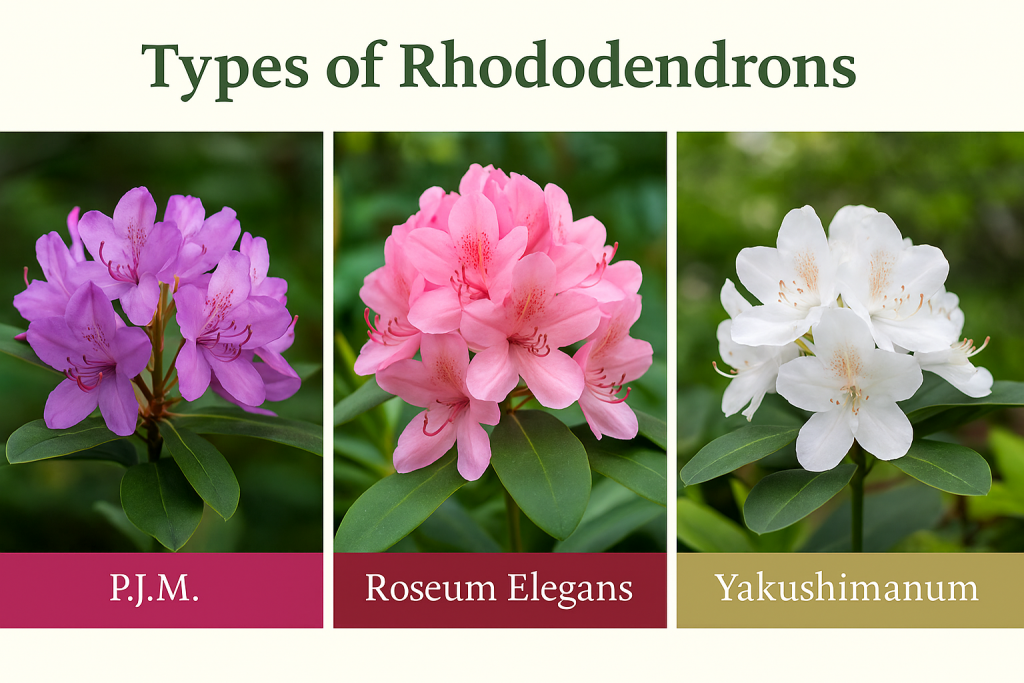
Companion Plants for Rhododendrons
Pair Rhododendrons with other shade-loving or acid-loving plants for a beautiful, low-maintenance garden:
- Azaleas: These acid-loving plants thrive in similar conditions to Rhododendrons, creating a harmonious blend of color and texture.
- Hostas: Planting Hostas beneath Rhododendrons adds lush foliage and contrast, especially in shady areas.
- Fern: Ferns complement the vibrant flowers of Rhododendrons with their delicate, feathery foliage.

FAQ: Common Rhododendron Questions
Why isn’t my Rhododendron blooming?
Ensure your Rhododendron is planted in full or partial shade and is not over-fertilized. Lack of blooms may also be due to heavy pruning, as cutting back too much can remove next year’s flower buds.
How do I protect my Rhododendron from winter damage?
Rhododendrons can suffer from winter burn or frost damage. To protect your plant, mulch around the base and provide winter protection by shielding the plant with burlap or planting in a sheltered location.
Enjoy Rhododendrons in Your Garden
Rhododendrons are exceptional plants that add vibrant color, fragrance, and structure to your garden. With their stunning flowers, glossy foliage, and ability to thrive in shaded areas, Rhododendrons make an ideal choice for any landscape. By following the care guidelines in this guide, you can enjoy a healthy, thriving Rhododendron that will bloom beautifully every spring.

